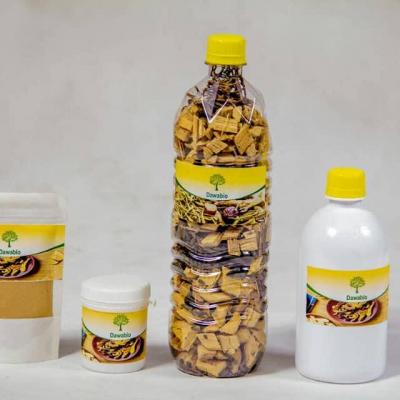HCV is a virus from the family Flaviviridae. It is estimated that around 170 million people are infected worldwide. In Africa, this number is 700,000 and 2,000 are recognized each year. Most hepatitis C infections are asymptomatic.

Hepatitis C - what is it?
Hepatitis C was a few decades to twelve years ago called non-A hepatitis - not B, that is, it was not caused by commonly known viruses.
It is an infectious disease which is responsible for the development of the hepatitis C virus which attacks liver cells (hepatocytes). The virus is transmitted by blood or other secretions, it is not transmitted orally (unlike the less common hepatitis A or hepatitis E viruses.
WELL ! dear patiens, you suffer from hepatitis b, c?
Don't scratch anything! we offer you a treatment based on powerful African plants to permanently cure hepatitis.
NATURAL TREATMENT AGAINST HEPATITIS B, C
The natural treatment that we offer to cure hepatitis B, like hepatitis C, is essentially made of natural herbal teas. It is one of the best natural remedies to cure hepatitis. The natural remedy for hepatitis is made up of plants that have been proven to work with dozens of cases resolved.
This natural remedy has anti-inflammatory and antioxidant properties, which help in healing and preventing liver problems. It also fights against the viruses responsible for hepatitis and provides the antioxidants that help maintain overall liver health. It helps the body fight viral infections and cleanse the liver.
To better understand its mode of action, we invite you to click on the image below or to contact our experts on +229 99 546 463.
Hepatitis natural treatment: better understanding the disease
Hepatitis C - morbidity
It is estimated that there are approximately 170,000,000 people infected with hepatitis C worldwide, and the number in Africa is 700,000. Most are asymptomatic or the symptoms are very mild, not forcing to start the diagnosis. Unfortunately, a large percentage of infected patients (up to 85%) develop chronic hepatitis, which can lead to cirrhosis.
Hepatitis C - causes
There are 3 main routes of infection :
- violation of tissue continuity and exposure to blood and other secretions,
- sexual contact
- perinatal infection (infection of the newborn by the mother).
The virus can be found in the blood, cerebrospinal fluid, synovial fluid, vaginal fluids and tears.
Potential situations that favor infection are:
- activities related to the rupture of the skin and mucous membranes, such as operations, dental procedures, cosmetic or hairdressing procedures, piercing, tattooing,
- blood transfusion (recipient's blood is tested for the presence of infectious agents, but infectious agents may not be detectable in a short period of time)
- contact with infected people,
- sexual contact with many partners, with unknown partners (mainly unprotected contacts, but remember that a condom is not 100% protection against diseases!),
- intravenous drug use
Hepatitis C - symptoms
The disease can be asymptomatic or have discreet symptoms, which are often overlooked or discreet. The incubation period (i.e. from the time of infection) includes:
- tired,
- low grade fever
- enlarged liver and pain
- muscle pain
- osteoarticular pain,
- Rashes,
- increased serum transaminases and bilirubin.
The symptoms of hepatitis C are similar in all types of hepatitis, regardless of the virus that causes them. The most common are:
- jaundice (yellowing of the skin and whites of the eyes), may be accompanied by darkening of the urine, sometimes discoloration of the stools, itching of the skin,
- flu-like symptoms (low fever, muscle, joint, and bone pain)
- dyspeptic symptoms (lack of appetite, nausea, vomiting),
- weakness,
- pain, distension, discomfort in the right hypochondrium caused by an enlarged liver.
Chronic hepatitis C is often asymptomatic, fatigue and weakness are possible. Since chronic hepatitis poses a risk of developing cirrhosis, symptoms of cirrhosis may appear after different periods.
Hepatitis C - virus and hatching period
The culprit is the hepatitis C virus, which is an RNA virus (its genetic material is written in the strand of RNA). The natural host of the virus is human, liver cells called hepatocytes are susceptible to infection.
The incubation period (the time between infection and the onset of symptoms or results confirming infection) is on average 4 to 20 weeks. Immediately after infection, tests for hepatitis C can be negative despite the presence of a virus in the body (we are talking about the so-called diagnostic window).
Hepatitis C - diagnosis
The treatment of viral hepatitis is carried out by a doctor (specialist in infectious diseases), a hepatologist. When reporting to a doctor, regardless of the disease, it is necessary to determine what is wrong, since when the problems last. If there are several health problems, it is often important to:
- the part of your body in which the problems appeared (who was first, in what order they appeared),
- what's the worst
- how the nature of ailments changes over time (are they all the same or do they change).
In case of pain, it is important to plan:
- painful areas (visible by hand),
- determination of the nature of the pain (constant, acute, burning, wrinkled, unbearable, weak),
- Determination of factors affecting the severity of the pain (for example, change of position, specific movement, meal).
Hepatitis C - home treatment
Here are three plants that are exceptional liver regenerators.
- thistle

Infusion: ground seeds are used from the plant - a teaspoon tip in a cup of boiling water; drink two cups / day, the first - in the morning, before a meal, and the second is shared after lunch and dinner; rest is necessary after each administration: lie down, 20 minutes, on the right side; the treatment lasts 10 days.
- celandine

Infusion: half a teaspoon of herbs in a cup of boiling water; drink two tablespoons of infusion at 3 hour intervals, then take a 12 hour break. Powder: a quarter of a teaspoon of teaspoon powder is taken sublingually, every four hours; the treatment lasts 10 days.
Decoction: especially use chicory root - boil, for five minutes, in 250 ml of boiling water, two teaspoons of the root roots; the decoction thus obtained is divided into three doses and one dose is drunk before the main meals; the treatment lasts 10 days.
- Care with green barley

Take, 3 times / day, before the main meals, 150 ml of green barley juice, for 2-3 weeks, only in summer. - Cure with black radish juice To drink, 3 days / month, summer and autumn, 300 ml of juice / day, in three halves.

